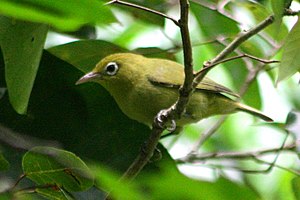| Trobriand Islands rain forests | |
|---|---|
 Fergusson Island from the sea Fergusson Island from the sea | |
 Ecoregion territory (in purple) Ecoregion territory (in purple) | |
| Ecology | |
| Realm | Australasian |
| Biome | tropical and subtropical moist broadleaf forests |
| Geography | |
| Area | 4,662 km (1,800 sq mi) |
| Country | Papua New Guinea |
| Province | Milne Bay Province |
| Coordinates | 9°32′S 150°40′E / 9.53°S 150.66°E / -9.53; 150.66 |
| Conservation | |
| Conservation status | vulnerable |
| Protected | 259 km² (6%) |
The Trobriand Islands rain forests are a tropical moist broadleaf forest ecoregion of southeastern Papua New Guinea.
The islands of this ecoregion have been separated from mainland New Guinea since the Late Pleistocene, and much of the biota is unique, including four mammal species and two birds-of-paradise plant species. The ecoregion covers 1,600 square miles (4,100 km).
Geography
The ecoregion includes several island groups lying east of the eastern peninsula of the island of New Guinea, within Milne Bay Province, including the d'Entrecasteaux Islands and Trobriand Islands archipelagoes, and Woodlark Island. The largest portion of the ecoregion and the nearest to the New Guinea mainland is made up of three principal islands of the d'Entrecasteaux group: Goodenough Island, Fergusson Island, and Normanby Island.
Flora
The Trobriand Islands and Woodlark Island consist primarily of lowland rain forest on limestone substrates. Goodenough, Fergusson, and Normanby Islands consist mainly of lowland rain forest on acid soil.
The major rain forest tree genera include Pometia, Octomeles, Alstonia, Campnosperma, Canarium, Dracontomelon, Pterocymbium, Cryptocarya, Intsia, Ficus, and Terminalia.
Tree species include:
- Alstonia breviloba
- Alstonia rubiginosa
- Canarium vitiense
- Dracontomelon dao
- Intsia bijuga
- Octomeles sumatrana
- Pometia pinnata
- Terminalia catappa
Fauna
Animal species native to the ecoregion include:
- Echymipera davidi
- Phalanger lullulae
- Dorcopsis atrata
- Dactylopsila tatei
- Nyctimene major
- Kerivoula agnella
- Pipistrellus collinus
- Chiruromys forbesi
- Greater tree mouse
- Island tube-nosed fruit bat
- Woodlark Cuscus

The ecoregion corresponds to the D'Entrecasteaux and Trobriand Islands endemic bird area. There are two endemic bird-of-paradise species, the curl-crested manucode (Manucodia comrii) and Goldie's bird-of-paradise (Paradisaea decora).
Conservation and threats
The main threats to the ecoregion include logging by foreign companies and conversion of habitat into agricultural lands.
References
- Eric Dinerstein, David Olson, et al. (2017). An Ecoregion-Based Approach to Protecting Half the Terrestrial Realm, BioScience, Volume 67, Issue 6, June 2017, Pages 534–545; Supplemental material 2 table S1b.
- ^ World Wildlife Fund.org: The Trobriand Islands rain forests (ID Code: AA0125) webpage; article originally from "Terrestrial ecoregions of the Indo-Pacific: a conservation assessment"; Island Press . accessed 3.17.2017.
- "Map of Ecoregions 2017". Resolve. Retrieved August 20, 2021.
- "Trobriand Islands rain forests". Digital Observatory for Protected Areas. Retrieved August 20, 2021.
- "Trobriand Islands rain forests". The Encyclopedia of Earth. Retrieved August 20, 2021.
- BirdLife International (2020) Endemic Bird Areas factsheet: D'Entrecasteaux and Trobriand Islands. Downloaded from http://www.birdlife.org on 30/05/2020.
External links
- "Trobriand Islands rain forests". Terrestrial Ecoregions. World Wildlife Fund.
| Papua New Guinea articles | |||||
|---|---|---|---|---|---|
| History |  | ||||
| Geography | |||||
| Politics | |||||
| Economy | |||||
| Society |
| ||||
| Melanesia | ||
|---|---|---|
| Sovereign states |  | |
| Other territories | ||
| Culture | ||
| Geography | ||
| Organizations | ||
| Politics | ||
| Sports | ||